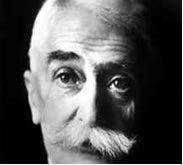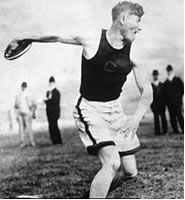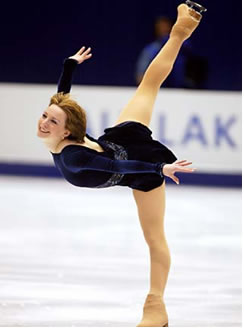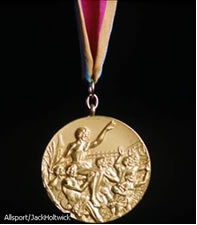One Hundred Years of Olympics
The modern Olympic Games, first held in 1896 in Athens , Greece , celebrated its first 100 years of international sports competition in 1996. In this article from the 1997 Collier's Year Book, senior editor Joseph Gustaitis traced the highlights of the century of games, including the triumph of Greek runner Spiridon (also spelled Spyridon) Louis in the 1896 marathon, the supremacy of Finnish runner Paavo Nurmi in the three games of the 1920s, and American athlete Jesse Owens's capture of four gold medals in track and field at the 1936 games in Berlin. Gustaitis pointed out that controversies over issues such as political boycotts and drug use have also played a role in the Olympic Games.
One Hundred Years of Olympics
By Joseph Gustaitis
 The modern-day Olympics celebrated their 100th birthday in 1996 with an extravaganza of a show. They had come a long way from their modest origins. The 1996 games boasted the most athletes, most countries, and most medal winners in history.
The modern-day Olympics celebrated their 100th birthday in 1996 with an extravaganza of a show. They had come a long way from their modest origins. The 1996 games boasted the most athletes, most countries, and most medal winners in history.In their century of existence, however, the Olympics had not lost sight of their founder's vision of sport as a means of bringing the peoples of the globe together. Concerns were widely voiced in 1996 over the ubiquitous influence of the almighty dollar, but the Olympics still maintained the power to captivate the world in a quadrennial display of the loftiest heights that the frail human frame can scale.
Coubertin the Visionary
 The first modern Olympic Games were inspired by a British schoolmaster, organized by a Frenchman, and held in Greece .
The first modern Olympic Games were inspired by a British schoolmaster, organized by a Frenchman, and held in Greece .
That French visionary was an undersized, hyperkinetic aristocrat named Baron Pierre de Coubertin (1863-1937). An accomplished fencer, boxer, and rower, he visited Britain in 1887 and was impressed by the zeal with which students there took part in athletics. Thomas Arnold (1795-1842), a Rugby School headmaster famed as an educational reformer, became his idol. Arnold had drawn attention to the character-building value of sports, and Coubertin developed into a crusader for physical education.
In 1889, Coubertin organized the Congress of Physical Education in Paris , and three years later he revealed plans to revive the Olympic Games of the ancient Greeks. The baron hoped the Olympics might promote international amity through peaceful competition. To further his idea, Coubertin established the International Olympic Committee (IOC). The first Olympic Games were originally slated to be held in Paris in 1900, but Coubertin grew impatient and moved the date to 1896.
The Festival Begins

It seemed fitting that the honor of hosting the games should fall to Athens . Funding was a problem―the Greek government was in debt―but a Greek millionaire named George Averoff helped out with a donation. An arena was built on the foundations of the long-vanished Panathenaic Stadium, and the first modern Olympics opened on April 6, 1896.
Because the surface of the new track was so loose, the times in the running events were slow. The era's training standards were such that Robert Garrett of the United States won the discus event even though he had never thrown an Olympic discus before coming across one in Athens (the homemade discus he had experimented with―and given up on―at home turned out to be much heavier than the official one). The swimming events were held in the sea near Piraeus ; the water was so cold that one American competitor, after plunging in, screamed and fled back to the start. Yet the games were well run and, in terms of spectacle and enthusiasm, would not be matched for many years.
The 1896 games provided one of the most stirring moments in Olympic history. Up until the marathon, the Americans had dominated the track-and-field events, and, as one U.S. athlete, Ellery H. Clark, later wrote, "The Greeks seemed to feel that the national honor was at stake." As the fans awaited the marathon victor in the stadium, a Greek horseman galloped in and delivered a message to the royal box. Soon a great cry went up, "Elleen! Elleen!" (A Greek! A Greek!), whereupon Spiridon Louis of Greece ran into the tumultuous stadium as thousands of pigeons soared into the sky. The modern Olympics had its first hero.
Getting over the Hurdles
 The next three Olympics attracted more athletes and saw stronger performances but otherwise did not measure up to Athens . The 1900 Paris Olympics were upstaged by the concurrent Exposition Universelle and were spread out over two months. The 1904 games in remote St. Louis were subordinated to the Louisiana Purchase Exhibition; over three-fourths of the competitors were Americans, and even Coubertin did not attend. The 1908 London Olympics were also overshadowed by another event (the Franco-British Exhibition), and the competition was stained by nasty arguments over rules between the visitors and their British hosts.
The next three Olympics attracted more athletes and saw stronger performances but otherwise did not measure up to Athens . The 1900 Paris Olympics were upstaged by the concurrent Exposition Universelle and were spread out over two months. The 1904 games in remote St. Louis were subordinated to the Louisiana Purchase Exhibition; over three-fourths of the competitors were Americans, and even Coubertin did not attend. The 1908 London Olympics were also overshadowed by another event (the Franco-British Exhibition), and the competition was stained by nasty arguments over rules between the visitors and their British hosts.
But the 1912 games in Stockholm were a success. Over 2,500 athletes took part, including 57 women. (They had first been allowed to participate in 1900―in golf and tennis. By 1912 women's swimming was on the program.) The star of the games was Jim Thorpe of the United States . Thorpe, who was primarily of American Indian descent, began with a victory in the pentathlon so decisive that he could have sat out the final event and still won the gold medal. He followed with a decathlon triumph that obliterated the world record by nearly 1,000 points. Thorpe's subsequent history is a sad tale. It was discovered that he had once earned $ 25 a week playing minor league baseball, and his medals were rescinded; he died in poverty in 1953. Three decades later his medals were restored―to his children.
Because Thorpe earned money by playing a sport, he was technically not an amateur, and as early as 1892 the IOC insisted that every Olympic competitor be one. Yet the question of who is―and isn't―an amateur perplexed the IOC from the start. At first, the amateurism requirement barred not just persons who played sports for money but anyone who received wages for labor of almost any kind. Eventually amateurism came to exclude only those―like Thorpe―who profited from athletics. Yet as early as the 1920s the British complained that U.S. college athletes were violating the spirit of amateurism by accepting scholarship funds. And when Communist regimes began building their sports machines, they claimed that because professional sport did not exist in their lands, all of their athletes were, by definition, amateurs, even though state funds were poured into training them. In 1988 the IOC decided to let the various international sporting federations determine whether professionals could compete in the Olympics. Today, only Olympic baseball and boxing bar professionals (soccer admits them, but to a limited extent).
A Parade of Stars
Because of World War I, the 1916 games, scheduled for Berlin , were not held; the Olympics picked up again in Antwerp in 1920. The 1920s saw the emergence of a phenomenal group of athletes from Finland . Led by the runner Paavo Nurmi, whose record of nine lifetime gold medals in track and field went unequaled until Carl Lewis of the United States won his ninth in 1996, the Finns went on a rampage extending over three Olympics. In the 1924 Paris Games, for example, Finland finished second to the United States with 14 gold medals, 13 silver, and ten bronze. 
The first Winter Olympic Games were held in Chamonix , France , in 1924. The 1928 Winter Games in St. Moritz , Switzerland , witnessed the first of three consecutive gold medals in figure skating by the Norwegian Sonja Henie, who revolutionized her sport with her balletic moves.
In 1932 the Olympics came to Los Angeles, where the first bona fide female track and field star emerged―Mildred ("Babe") Didrikson of Texas, who set world records in the high jump and 80-meter hurdles and won the gold medal in the javelin on her first throw.
Sponsors, Money, and Television
 When the 1992 games arrived in Barcelona , it was clear that there was a huge new factor in Olympic life―commercialism and marketing. The streets were plastered with billboards identifying products with athletes, one of the most prominent being U.S. basketball titan Michael Jordan. Of course, the billboards were signs of success―the Olympics had become a huge hit, a marketer's dream. The U.S. television rights for the Barcelona games went for $400 million; in 1995, NBC-TV bought the U.S. rights to the games of 2000, 2002, 2004, 2006, and 2008 for a grand total of $3.55 billion. The organizers of the 1996 Atlanta Games used no public funds; to meet the $2.3 billion cost of hosting the spectacle, they relied not only on TV money and ticket sales, but also on hefty contributions from a host of corporate sponsors, resulting in a phantasmagoria of advertising.
When the 1992 games arrived in Barcelona , it was clear that there was a huge new factor in Olympic life―commercialism and marketing. The streets were plastered with billboards identifying products with athletes, one of the most prominent being U.S. basketball titan Michael Jordan. Of course, the billboards were signs of success―the Olympics had become a huge hit, a marketer's dream. The U.S. television rights for the Barcelona games went for $400 million; in 1995, NBC-TV bought the U.S. rights to the games of 2000, 2002, 2004, 2006, and 2008 for a grand total of $3.55 billion. The organizers of the 1996 Atlanta Games used no public funds; to meet the $2.3 billion cost of hosting the spectacle, they relied not only on TV money and ticket sales, but also on hefty contributions from a host of corporate sponsors, resulting in a phantasmagoria of advertising.
About the author: Joseph Gustaitis is a senior editor on the Collier's Year Book staff.
Source: 1997 Collier's Year Book.
Microsoft ? Encarta ? Reference Library 2005. ? 1993-2004 Microsoft Corporation.